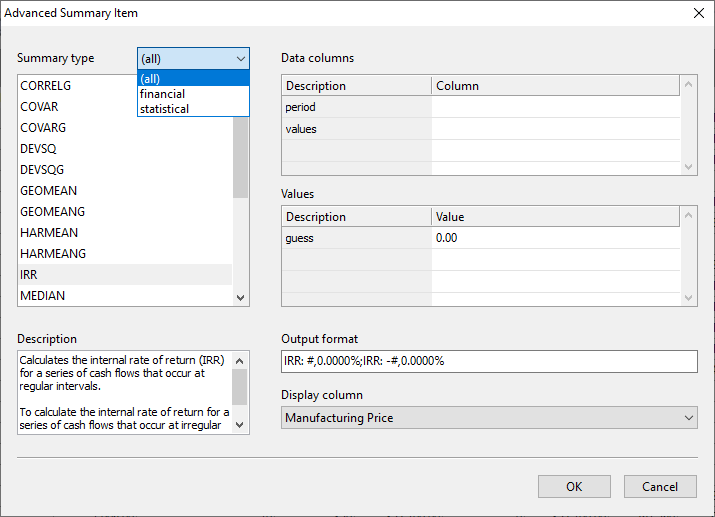In addition to the standard summary functions, SQL Data Analysis can also calculate financial and statistical summaries. To use these advanced summaries, right click on the column header and select the advanced option.

The Advanced Summary Item window is displayed. You can then select a financial or statistical function to add to your analysis table.

The available statistical functions are as follows:
AVEDEV |
Calculates the average of the absolute value of deviations from the mean for a given set of data. |
AVEDEVG |
Calculates the average of the absolute value of deviations from the mean for a given set of data, grouped by periods. |
DEVSQ |
Calculates the sum of the squared deviations from the mean for a given set of data. |
DEVSQG |
Calculates the sum of the squared deviations from the mean for a given set of data, grouped by periods. |
STDEV |
Calculates the standard deviation for a given set of data. |
STDEVG |
Calculate the standard deviation for a given set of data, grouped by periods. |
STDEVP |
Calculates the standard deviation for a given set of data representing an entire population. |
STDEVPG |
Calculates the standard deviation for a given set of data representing an entire population, grouped by periods. |
GEOMEAN |
Calculates the geometric mean for a set of numeric values. |
GEOMEANG |
Calculates the geometric mean for a set of numeric values, grouped by periods. |
HARMEAN |
Calculates the harmonic mean for a set of numeric values. |
HARMEANG |
Calculates the harmonic mean for a set of numeric values, grouped by periods. |
TRIMMEAN |
Calculates the mean (average) while excluding outliers. |
TRIMMEANG |
Calculates the mean (average) while excluding outliers, grouped by periods. |
MEDIAN |
Calculates the median (middle number) in a group of supplied numbers. |
MEDIANG |
Calculates the median (middle number) in a group of supplied numbers, grouped by periods. |
MODE |
Returns the most frequently occurring number in a numeric data set. |
CORREL |
Calculates the correlation coefficient between 2 numeric data sets. |
CORRELG |
Calculates the correlation coefficient between 2 numeric data sets, grouped by period |
COVAR |
Calculates the covariance, the average of the products of deviations for two data sets. |
COVARG |
Calculates the covariance, the average of the products of deviations for two data sets, grouped by periods. |
The available financial functions are as follows:
IRR |
Calculates the internal rate of return (IRR) for a series 'of cash flows that occur at regular intervals.
To calculate the internal rate of return for a series of cash flows that occur at irregular intervals, use the XIRR function. |
MIRR |
Calculates the modified internal rate of return (MIRR) for a series of cash flows, taking into account both discount rate and reinvestment rate for future cash flows. |
XIRR |
Calculates the internal rate of return (IRR) for a series of cash flows that occur at irregular intervals.
To calculate the internal rate of return for a series of regular, periodic cash flows, use the IRR function. |
NPV |
Calculates the net present value (NPV) of an investment using a discount rate and a series of future cash flows.
To calculate the net present value for a series of cash 'flows that occur at irregular intervals, use the XNPV function. |
XNPV |
Calculates the net present value (NPV) of an investment using a discount rate and a series of cash flows that occur at irregular intervals
To calculate the net present value for a series of regular, 'periodic cash flows, use the NPV function. |